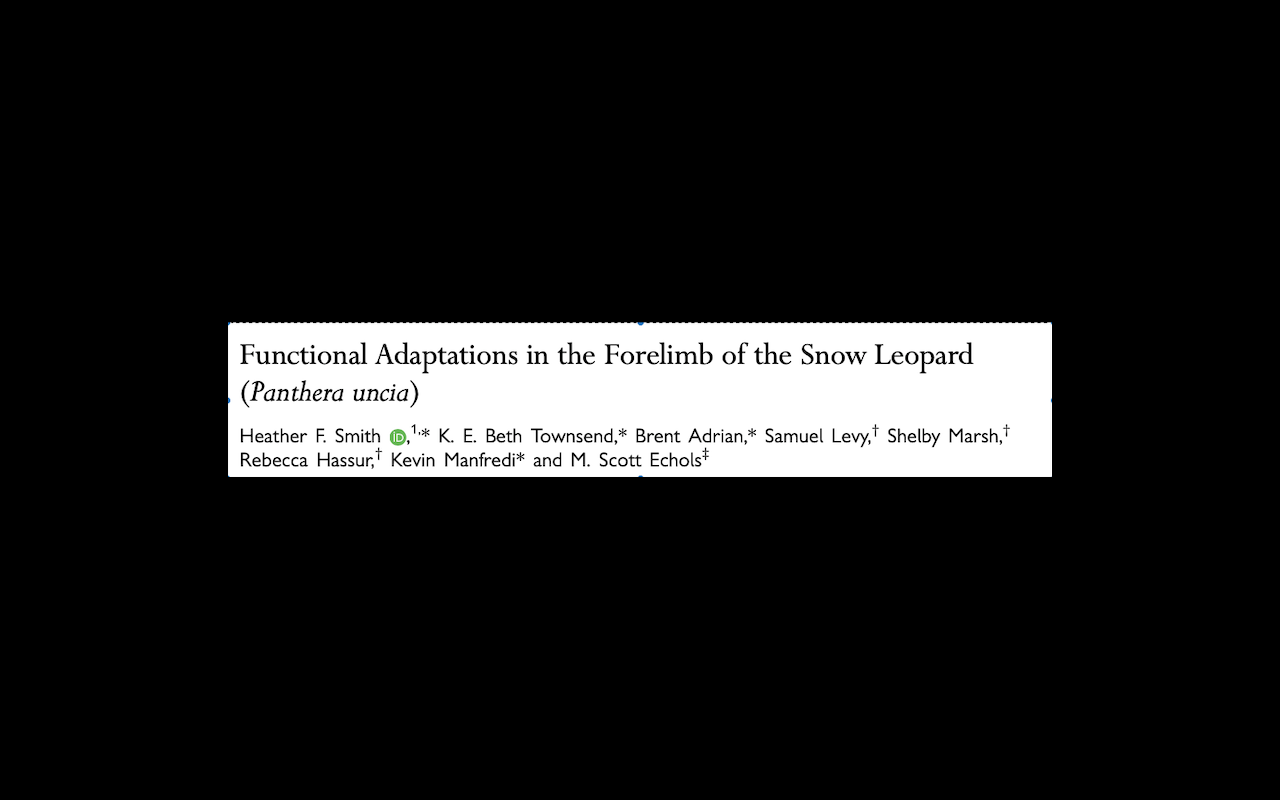
URL:


Please find details below of a new article added to our Bibliography:
Title: Snow leopards and prey in Rolwaling Valley, Gaurishankar Conservation Area, Nepal
Author: Pandey, B. P., Thami, S., Shrestha, R., Subedi, N., Chalise, M. K., Ale, S. B.
Abstract: The snow leopard Panthera uncia, an apex predator of the Himalayan ecosystem, often shares habitat with the wolf, Canis lupus, red fox Vulpes vulpes, and other carnivores. A biodiversity monitoring programme primarily focused on the assessment of the status of snow leopard and its prey in Rolwaling valley of Gaurishankar Conservation Area, Nepal, was carried out during June–November 2019. We deployed single camera traps in each of twelve grids sized 16 km2 each, operated 24 hours, and left alone for the whole study period. A single snow leopard was captured thrice on same camera in Rhododendron anthopogon-Hippophae thibetana scrubland, near Tsho Rolpa glacial lake (4,536 m). Alongwith snow leopard, wolves were also photographed at three sites namely Yelung pass (4,956 m), Tsho Rolpa (4,536 m) and Dudhkunda ridgeline (5,091 m). The red fox was the most frequent predator in Rolwaling while stone marten Martes foina, yellow-throated marten Martes flabigula, and yellow-belied weasel Mustella katiyah were captured occasionally. Photo capture rate index PCRI per 100 trap nights was calculated for all identifiable species where snow leopard and wolf had PCRI values of 0.35 and 0.71, respectively. The Cumulative PCRI values suggest a pyramid shaped community structure in Rolwaling with small herbivores (including game birds) with broad base (PCRI 22.29) followed by large herbivores (10.38) and small-medium sized carnivores (6.96). The top predators (snow leopard and wolf) produces 1.06 photographic rate index. The declaration of Gaurishankar conservation area and continuous efforts from conservation area management committees, strict cultural rules from local Buddhist community in the valley are found possibly favoured the recolonization of the wolf and frequent visits by snow leopard.
URL: https://snowleopardnetwork.org

Please find details below of a new article added to our Bibliography:
Title: An experience of surplus killing of livestock by a snow leopard in Nepal
Author: Thapa, K.
Abstract: Among many other threats, retaliatory killing of snow leopards Panthera uncia by people in retribution of livestock depredation is the foremost challenge for long-term survival of snow leopards. Surplus killing of up to 100 or more goats and sheep by snow leopard in a single night have been reported in snow leopard range’ countries including Nepal. Such incidences are unusual, but their impacts are substantial for subsistence agropastoral communities and snow leopard survival. Direct observation of surplus killing of livestock by a snow leopard in the corral is very rare. Here I report one incidence in a remote part of Nepal where a snow leopard killed 44 goats and was then trapped itself in a corral. This note highlights how I managed to rescue the trapped snow leopard.
URL: https://snowleopardnetwork.org
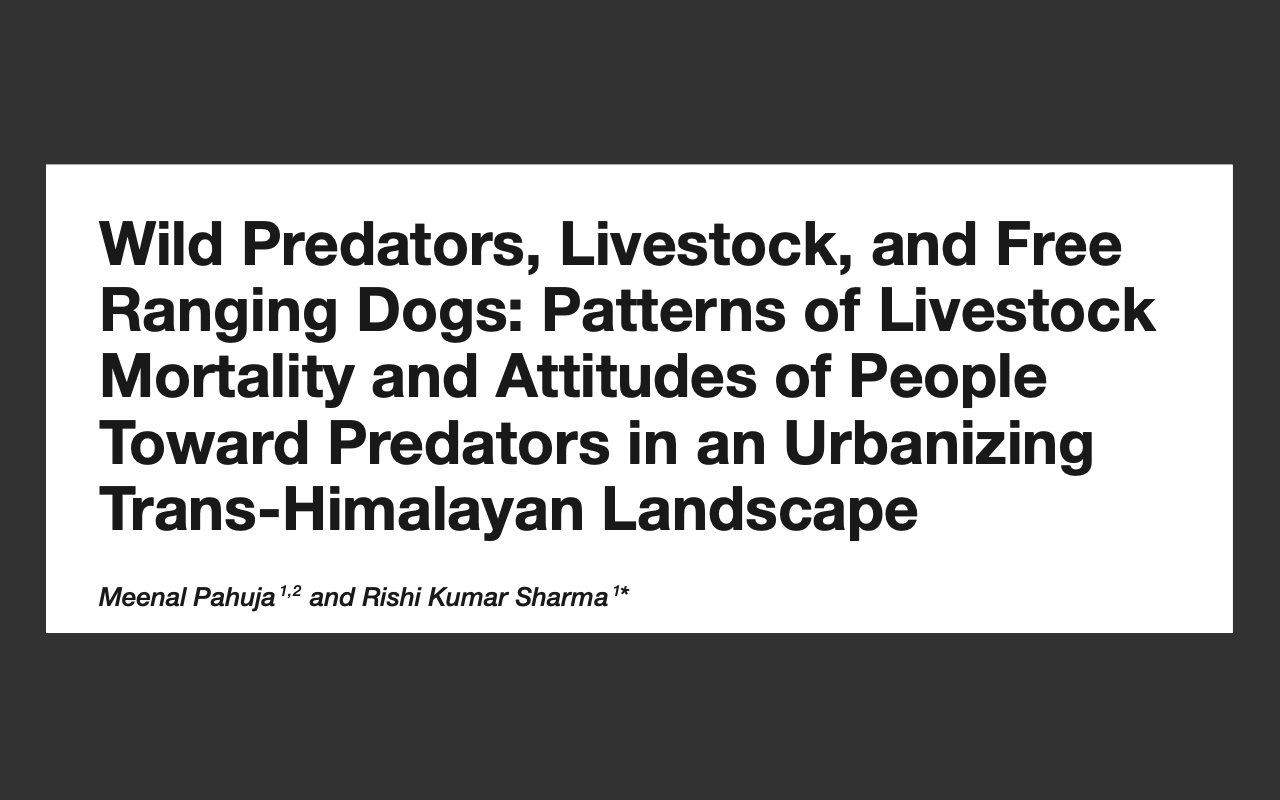
Please find details below of a new article added to our Bibliography:
Title: Wild Predators, Livestock, and Free Ranging Dogs: Patterns of
Livestock Mortality and Attitudes of People Toward Predators in an
Urbanizing Trans-Himalayan Landscape
Author: Pahuja, M., Sharma, R. K.
Abstract: Livestock depredation by large carnivores is a significant
source of conflicts over predators and an important conservation and
economic concern. Preventing livestock loss to wild predators is a
substantial focus of human-carnivore conflict mitigation programs. A key
assumption of the preventive strategy is reduction in the livestock
losses leading to a positive shift in the attitudes toward predators.
Therefore, it is important to quantify the true extent of livestock
mortality caused by wild predators and its influence on attitudes of the
affected communities. We examined seasonal and spatial patterns of
livestock mortality and factors influencing people’s attitudes toward
wild predators i.e., snow leopards (Panthera uncia) and wolves (Canis
lupus chanco) and free-ranging dogs (Canis lupus familiaris) in a
Trans-Himalayan urbanizing landscape in India. We used systematic
sampling to select the survey households and implemented a semi-
structured questionnaire to respondents. The sampled villages (n = 16)
represent a mosaic of urban and agricultural ecosystems within a radius
of 40 km of Leh town. In 2016–2017, 93% of the sampled households lost
livestock to predators, accounting for 0.93 animals per household per
year. However, of the total events of livestock mortality, 33% were
because of weather/natural events, 24% by snow leopards, 20% because of
disease, 15% because of free-ranging dogs and 9% because of wolves. The
annual economic loss per household because of livestock mortality was
USD 371, a substantial loss given the average per capita income of USD
270 in the region. Of the total loss, weather/natural events caused
highest loss of USD 131 (35%), followed by snow leopards USD 91 (25%),
disease USD 87 (24%), free ranging dogs USD 48 (13%), and wolves USD 14
(4%). Despite losing a considerable proportion of livestock (33 %) to
wild predators, respondents showed a positive attitude toward them but
exhibited neutral attitudes toward fre
e-ranging dogs. Gender emerged as the most important determinant of
attitudes toward wild predators, with men showing higher positive
attitude score toward wild predators than women. Our findings highlight
the context specific variation in human-wildlife interactions and
emphasize that generalizations must be avoided in the absence of site
specific evidence.
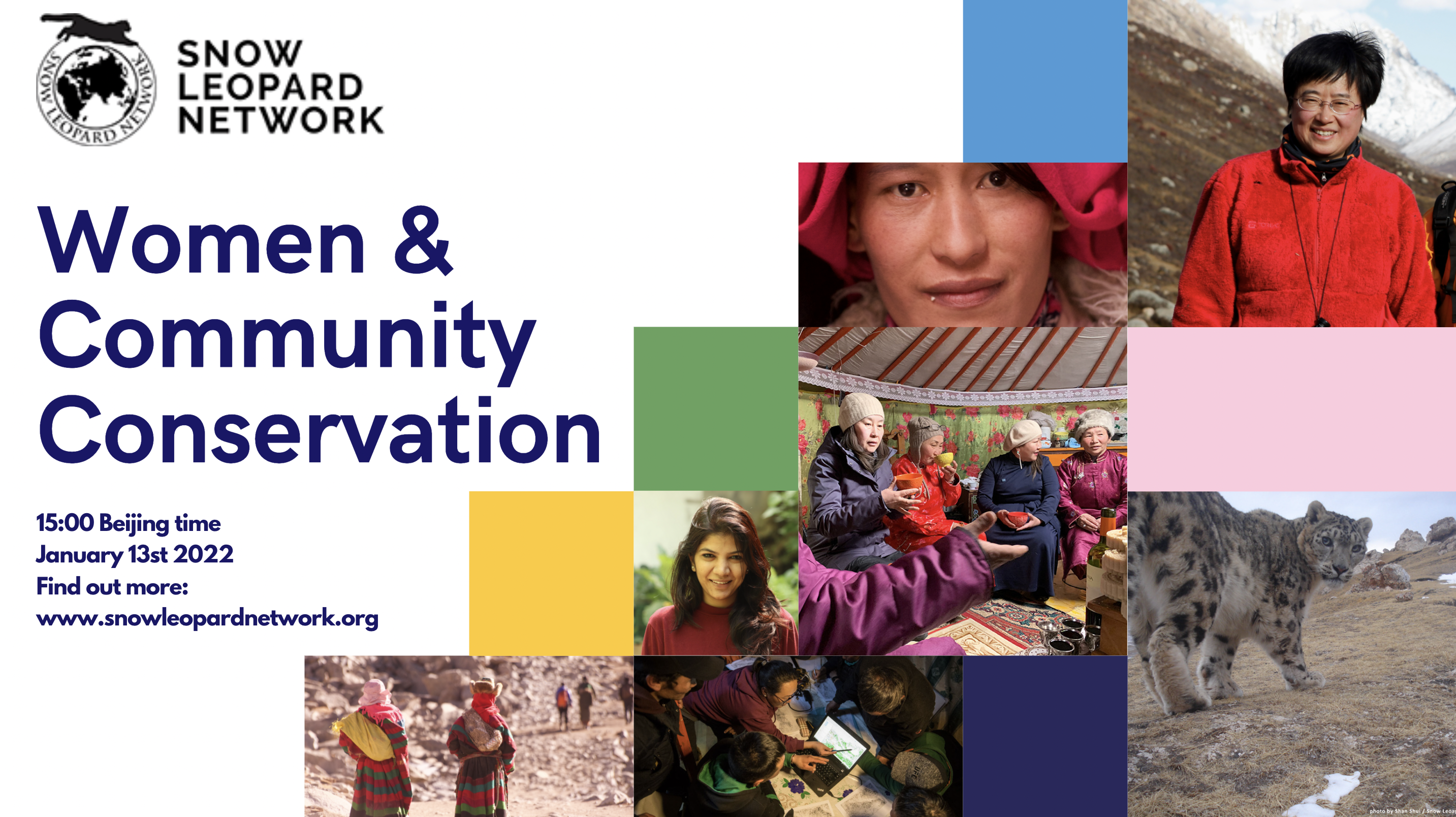
We are pleased to announce that this webinar previously scheduled in September 2021, (Part 1 of the series) – will take place on January 13th 2022.
Across the range, snow leopards and people share space. Engaging with local communities is essential for snow leopard conservation. Community based programmes tend to engage with men largely due to social norms and existing power structures. This often results in excluding women, who are important stakeholders and form almost 50% of the adult population, from conservation action and decision making.
In this webinar, we explore how to better engage women in conservation programs across the snow leopard landscape. We hear examples from existing programs that specifically target women and discuss how conservation programs can themselves shift social norms around gender equality (positively or negatively). We also examine the key role of policy in transforming community based programs through incorporating gender sensitive approaches.
We will be hearing from conservationists across the snow leopard range – Bayara Agvantsaaren, Dr. LuZhi and Rashmi Singh – who are working at different levels to engage women in snow leopard conservation. Each of them will highlight a particular aspect of their work that highlights the opportunities and challenges in promoting women’s role in community based conservation. Dr. Charudutt Mishra, the Executive Director of the Snow Leopard Trust, will facilitate the panel discussion. Charu has been a pioneer in community based conservation and brings a special perspective around how to make a difference at the ground level.
We hope to see you, all members both men and women, at this very special webinar and look forward to drawing on your experiences and insights during the discussion. This webinar is Part 1 of a Webinar Series focussing on the role of women in snow leopard conservation and science (watch the Part 2 recording which took place in September 2021).
Opening the webinar we first hear from the panelists, each with a five-minute presentation, where they set the context of their work and highlight key issues. This will be followed by the panel discussion facilitated by Dr. Charudutt Mishra for twenty minutes focusing on opportunities and identifying strategies and priorities for engaging women in conservation programmes. This will be followed by an open interaction with the audience.
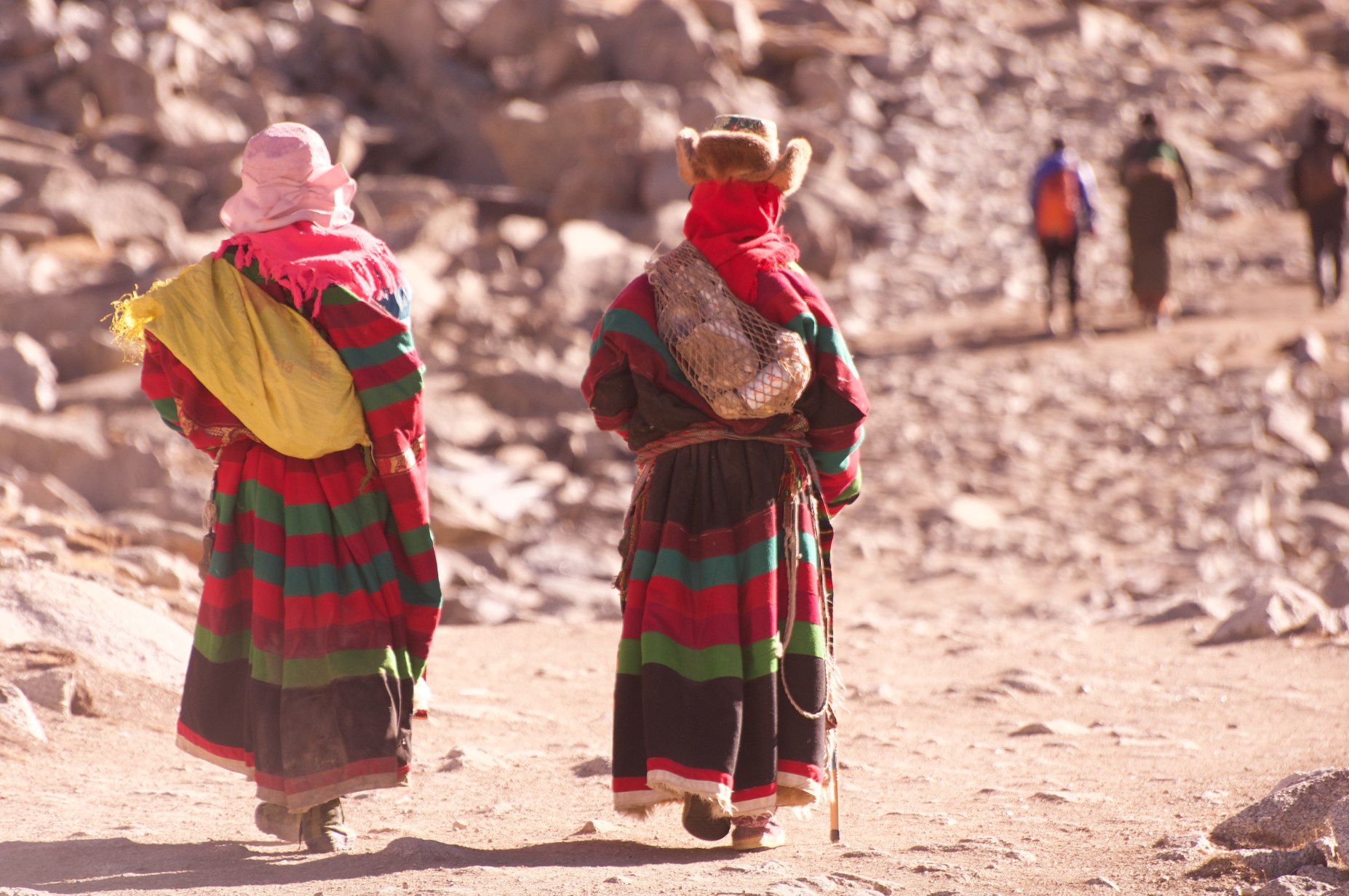
 Bayara Agvantsaaren is the Executive Director of Snow Leopard Conservation Foundation and Mongolia Program Director, at the Snow Leopard Trust. “I have been working as a snow leopard conservationist since 1998 when I co-found Snow Leopard Enterprises Program which offers income generation to women rural herders who share mountain with these elusive cats. It has been amazing 20+ years career journey to work with different aspects of conservation. I am privileged to be able to help both snow leopards and local people.” shares Bayara.
Bayara Agvantsaaren is the Executive Director of Snow Leopard Conservation Foundation and Mongolia Program Director, at the Snow Leopard Trust. “I have been working as a snow leopard conservationist since 1998 when I co-found Snow Leopard Enterprises Program which offers income generation to women rural herders who share mountain with these elusive cats. It has been amazing 20+ years career journey to work with different aspects of conservation. I am privileged to be able to help both snow leopards and local people.” shares Bayara.
 Professor Lu Zhi is a conservation biologist in China whose work covers multiple-disciplinary researches and bridging academic research and practices, in order to seek solutions for conservation and sustainable development in China and to promote China’s positive role in the world. She has studied ecology and conservation of endangered species in southwest China and on the Tibetan Plateau, such as the giant panda, the snow leopard, the blue sheep, the Tibetan brown bear and the Przewalski gazelle, as well as their interactions with human activities. In recent years, she focuses on mechanisms of coexistence between human and nature. She leads conservation initiatives on community-led conservation and citizen sciences in both rural and urban contexts based on economic incentives, cultural values and policy improvements. She involved in conservation policy making at regional and national levels, and is an active member of international conservation discussions.
Professor Lu Zhi is a conservation biologist in China whose work covers multiple-disciplinary researches and bridging academic research and practices, in order to seek solutions for conservation and sustainable development in China and to promote China’s positive role in the world. She has studied ecology and conservation of endangered species in southwest China and on the Tibetan Plateau, such as the giant panda, the snow leopard, the blue sheep, the Tibetan brown bear and the Przewalski gazelle, as well as their interactions with human activities. In recent years, she focuses on mechanisms of coexistence between human and nature. She leads conservation initiatives on community-led conservation and citizen sciences in both rural and urban contexts based on economic incentives, cultural values and policy improvements. She involved in conservation policy making at regional and national levels, and is an active member of international conservation discussions.
 Rashmi Singh is a PhD Scholar at the School of Human Ecology, Ambedkar University and Associate Editor for Pastoralism– research, policy and practice Journal. Her PhD work explores the politics of rangeland conservation in the Himalaya using an interdisciplinary approach. Her primary research interest includes disciplines of pastoral studies, rangeland conservation and animal geography. In the last nine years, she has worked extensively on the social dimensions of wildlife conservation across India. Her ongoing research has highlighted the importance of including pastoralists in the policy formulation, wildlife conservation, and management of rangelands. She is intrigued by the pastoral indigenous knowledge system and believes that long term regional studies are crucial for reconciling pastoral livelihood and rangeland conservation goals.
Rashmi Singh is a PhD Scholar at the School of Human Ecology, Ambedkar University and Associate Editor for Pastoralism– research, policy and practice Journal. Her PhD work explores the politics of rangeland conservation in the Himalaya using an interdisciplinary approach. Her primary research interest includes disciplines of pastoral studies, rangeland conservation and animal geography. In the last nine years, she has worked extensively on the social dimensions of wildlife conservation across India. Her ongoing research has highlighted the importance of including pastoralists in the policy formulation, wildlife conservation, and management of rangelands. She is intrigued by the pastoral indigenous knowledge system and believes that long term regional studies are crucial for reconciling pastoral livelihood and rangeland conservation goals.

Thursday, 13th January at 1500 Beijing/Shanghai time (13:00 Bishkek time)
Zoom – Register here
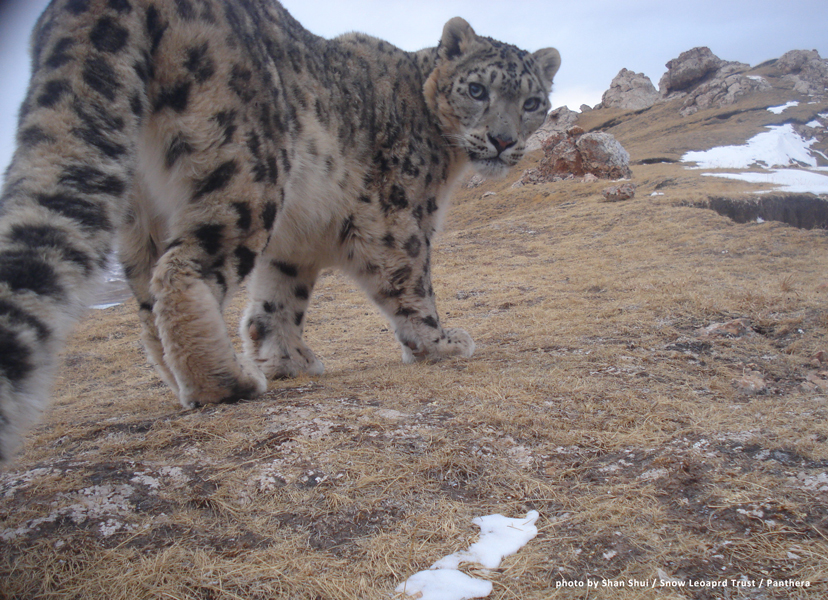
Please find details below of new articles added to our Bibliography:

Title: Modelling Potential Distribution of Snow Leopards in Pamir,
Northern Pakistan: Implications for Human–Snow Leopard Conflicts
Author: Rashid, W., Shi, J., Rahim, I. U., Qasim, M., Baloch, M. N.,
Bohnett, E., Yang, F., Khan, I., Ahmad, B.
Abstract: The snow leopard (Panthera uncia) is a cryptic and rare big
cat inhabiting Asia’s remote and harsh elevated areas. Its population
has decreased across the globe for various reasons, includ ing
human–snow leopard conflicts (HSCs). Understanding the snow leopard’s
distribution range and habitat interactions with human/livestock is
essential for understanding the ecological context in which HSCs occur
and thus gives insights into how to mitigate HSCs. In this study, a
MaxEnt model predicted the snow leopard’s potential distribution and
analyzed the land use/cover to de termine the habitat interactions of
snow leopards with human/livestock in Karakoram–Pamir, northern
Pakistan. The results indicated an excellent model performance for
predicting the species’ potential distribution. The variables with
higher contributions to the model were the mean diurnal temperature
range (51.7%), annual temperature range (18.5%), aspect (14.2%), and
land cover (6.9%). Th
e model predicted approximately 10% of the study area as a highly
suitable habitat for snow leopards. Appropriate areas included those at
an altitude ranging from 2721 to 4825 m, with a mean elevation of 3796.9
± 432 m, overlapping between suitable snow leopard habitats and human
presence. The human encroachment (human settlements and agriculture) in
suitable snow leopard habitat increased by 115% between 2008 and 2018.
Increasing encroachment and a clear overlap between snow leopard
suitable habitat and human activities, signs of growing competition
between wildlife and human/livestock for limited rangeland resources,
may have contributed to increasing HSCs. A sound land use plan is needed
to minimize overlaps between suitable snow leopard habitat and human
presence to mitigate HSCs in the long run.
URL: https://snowleopardnetwork.org

Title: No silver bullet? Snow leopard prey selection in Mt.
Kangchenjunga, Nepal
Author: Thapa, K., Schmitt, N., Pradhan, N. M. B., Acharya, H. R.,
Rayamajhi, S.
Abstract: In this study, we investigated the impact of domestic and wild
prey availability on snow leopard prey preference in the Kangchenjunga
Conservation Area of eastern Nepal-a region where small domestic
livestock are absent and small wild ungulate prey are present. We took a
comprehensive approach that combined fecal genetic sampling, macro- and
microscopic analyses of snow leopard diets, and direct observation of
blue sheep and livestock in the KCA. Out of the collected 88 putative
snow leopard scat samples from 140 transects (290km) in 27 (4x4km2)
sampling grid cells, 73 (83%) were confirmed to be from snow leopard.
The genetic analysis accounted for 19 individual snow leopards (10 males
and 9 females), with a mean population size estimate of 24 (95% CI:
19-29) and an average density of 3.9 snow leopards/100km2 within 609km2.
The total available prey biomass of blue sheep and yak was estimated at
355,236 kg (505 kg yak/km2 and 78kg blue sheep/km2). From the available
prey
biomass, we estimated snow leopards consumed 7% annually, which
comprised wild prey (49%), domestic livestock (45%). and 6% unidentified
items. the estimated 47,736 kg blue sheep biomass gives a snow
leopard-to-blue sheep ratio of 1:59 on a weight basis. The high
preference of snow leopard to domestic livestock appears to be
influenced by a much smaller available biomass of wild prey then in
other regions of Nepal (e.g., 78kg/km2 in the KCA compared with a range
of 200-300 kg/km2 in other regions of Nepal?. Along with livestock
insurance scheme improvement, there needs to be a focus on improved
livestock guarding, predator-proof corrals as well as engaging and
educating local people to be citizen scientists on the importance of
snow leopard conservation, involving them in long-term monitoring
programs and promotion of ecotourism.
URL: https://snowleopardnetwork.org
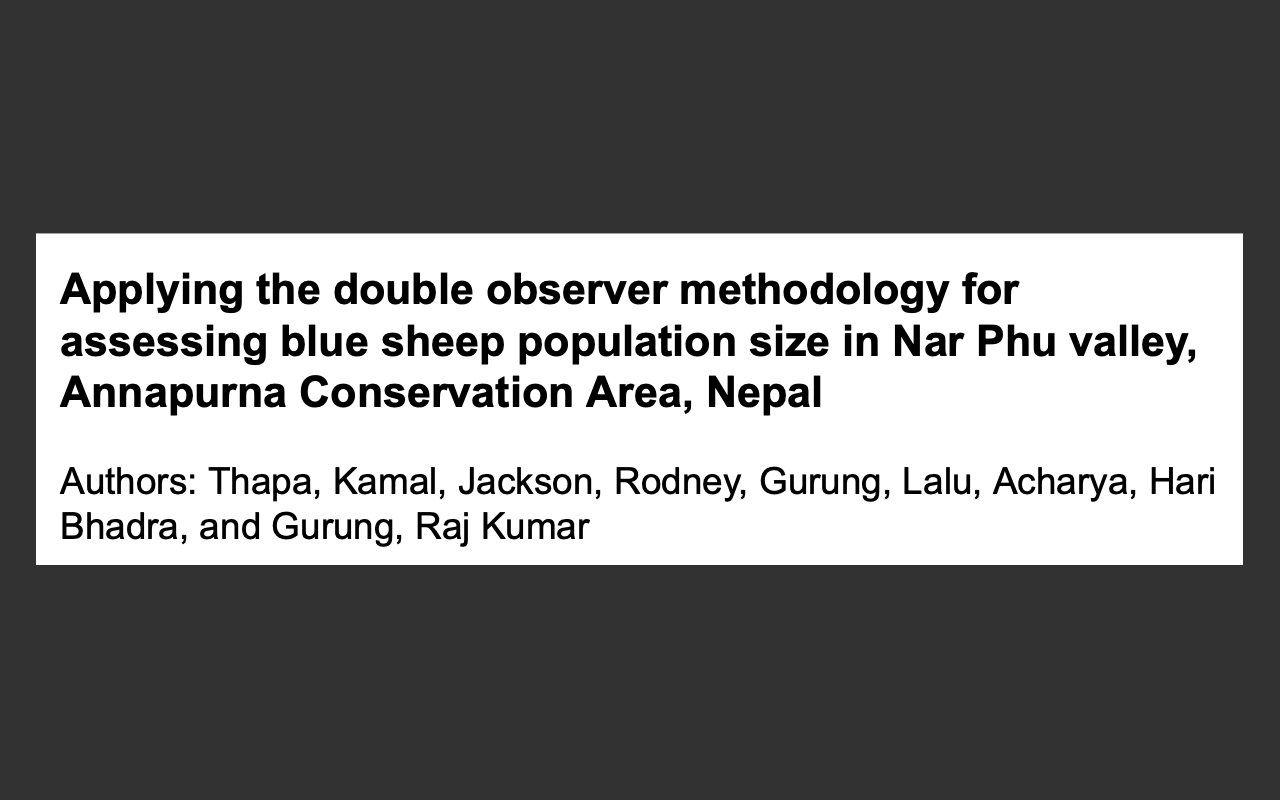
Title: Applying the double observer methodology for assessing blue sheep
population size in Nar Phu valley, Annapurna Conservation Area, Nepal
Author: Thapa, K., Jackson, R., Gurung, L, Acharya, H. B., Gurung, R.
K.,
Abstract: This study was undertaken in spring, 2019 to assess the
applicability of the double-observer survey method for estimating blue
sheep Pseudois nayaur abundance in Nar-Phu valley of Manang District
located in Annapurna Conservation Area of northern Nepal. Since counting
large mammals in rugged mountain habitat poses a special challenge, we
tested the efficacy of the double observer method for generating robust
population estimates for this important protected area. The overall
detection probability for observers (O1 and O2) was 0.94 and 0.91 for a
total of 106 groups comprised of 2059 individual blue sheep. We
estimated the area’s blue sheep population at 2070 (SE ± 168.77; 95% CI
2059–2405) for the 246.2 km2 of sampled habitat. We determined blue
sheep to be widely distributed within the study area with a mean density
of 8.4 individuals per km2 based on a total study area of 246.2 km2. We
discuss demographic population structure and identify limitations when
applying
the double observer approach, along with recommending viewshed mapping
for ensuring more robust density estimates of mountain-dwelling
ungulates like blue sheep or ibex that inhabit extremely heterogeneous
terrain which strongly influences sighting distances and overall animal
detection rates.
Please find details below of a new article added to our Bibliography:
Title: Landscape connectivity and population density of snow leopards across a multi-use landscape in Western Himalaya
Author: Pal, R., Sutherland, C., Qureshi, Q., Sathyakumar, S.
Abstract: Human modification and habitat fragmentation significantly impact large carnivores requiring large, connected habitats to persist in a landscape. Understanding species responses to such change and the protection of critical areas and connectivity they provide is essential when planning effective conservation strategies. Our study examines the spatial distribution of the snow leopard (Panthera uncia) across a gradient of protection status, anthropogenic pressures and habitat types in the Gangotri landscape (~4600 km2), Western Himalaya. Using spatial capture-recapture modeling, we analyzed a 4-year camera trapping dataset (2015–2019) to assess the relationship between snow leopard movement and topography and identified the conducible areas for facilitating movement across the landscape. Snow leopard density was positively associated with elevation and slope, and was higher in protected areas (summer: 1.42 SE 0.02/100km2; winter 2.15 SE 0.03 vs. summer: 0.4 SE 0.01; win
ter: 0.6 SE 0.01 for unprotected areas). Precipitous terrain and several prominent mountain peaks were found to be resistant to snow leopard movement. Even with a range of human activities inside protected areas, the higher density suggests a positive impact of protection. Density-weighted connectivity showed that conducible areas are available between the Gangotri landscape and the adjacent protected areas. However, compared to protected area, these areas are relatively less used and require attention for management. We recommend regulating human activities and co-managing pastures with local communities to revive prey base outside protected areas, especially in corridors, to ensure such areas are functionally conducive. Our study provides a framework to collectively quantitate the spatial pattern of abundance, distribution and connectivity. Our approach has broad applicability for policymakers to develop strategic plans for balancing the conservation of species, and other land uses in a multi-use landscape.
URL:

Please find details below of a new article added to our Bibliography:
Title: First spatially‐explicit density estimate for a snow leopard population in the Altai Mountains
Author: Oberosler, V., Tenan, S., Groff, C., Krofel, M., Augugliaro, C., Munkhtsog, B., Rovero, F.
Abstract: The snow leopard Panthera uncia is an elusive and globally-threatened apex predator occurring in the mountain ranges of central Asia. As with other large carnivores, gaps in data on its distribution and abundance still persist. Moreover, available density estimates are often based on inadequate sampling designs or analytical approaches. Here, we used camera trapping across a vast mountainous area (area of the sampling frame 850 km2; analysed habitat extent 2600 km2) and spatially-explicit capture-recapture (SECR) models to provide, to our knowledge, the first robust snow leopard population density estimate for the Altai Mountains. This region is considered one of the most important conservation areas for snow leopards, representing a vast portion of suitable habitat and a key ecological corridor. We also provide estimates of the scale parameter (σ) that reflects ranging behaviour (activity range) and baseline encounter probability, and investigated potential drivers of
density and related parameters by assessing their associations with anthropogenic and environmental factors. Sampling yielded 9729 images of snow leopards corresponding to 224 independent detections that belonged to a minimum of 23 identified adult individuals. SECR analysis resulted in an overall density of 1.31 individuals/100 km2 (1.15%–1.50 95% CI), which was positively correlated with terrain slope. This estimate falls within the mid-values of the range of density estimates for the species globally. We estimated significantly different activity range size for females and males (79 and 329 km2, respectively). Base- line encounter probability was negatively associated with anthropogenic activity. Our study contributes to on-going efforts to produce robust global estimates of population abundance for this top carnivore.
The Eurasian lynx co-exists with the snow leopard in parts of its range. Conservation of the two species are interconnected and collaborative efforts have the potential to strengthen each other. A large body of knowledge about the lynx has been gathered in Europe over the last half century. SLN’s coming webinar will introduce us to the lessons drawn from Eurasian lynx conservation efforts in Switzerland.
SLN is pleased to invite Christine Breitenmoser-Würsten and Urs Breitenmoser to lead this webinar on Monday, 6th December, 2021 at 10 am CET. Sandro Lovari, SLN’s Steering Committee Chair will facilitate the discussion around this exchange of learnings. We look forward to this session which goes broader than the snow leopard, as requested by many members.

The Eurasian lynx is one of the most widespread cats of the world, but in its western range, in Europe, it was almost eradicated in the 19th century. Today, the autochthonous populations in northern and eastern Europe have recovered, and in west and central Europe, several populations were reintroduced.
The first successful reintroduction was in the Swiss Alps in 1971. The reintroduction was possible because in the first half of the 20th century, the forests – habitat of the lynx – and wild ungulates such as roe deer or chamois have recovered, reconstituting the ecological framework for the return of the lynx. However, people had lost their ancient knowledge of cohabitation with large carnivores, and the return of an efficient predator and competitor was a big challenge for the human community.
Nowadays, the lynx is broadly accepted. However, the reintroduction was an extreme population bottleneck, and 50 years after the first releases, the genetic situation of the population is a major concern. The fall and raise of the megafauna – both herbivores and carnivores – were tightly connected to long-term societal and economic development and the transition from a more agricultural society to an urban industrial and service society. Such experience – both negative and positive – can help to better foresee and mitigate human-carnivore conflicts in the fast changing world of Asia.


Christine Breitenmoser-Würsten and Urs Breitenmoser both have a PhD in zoology from the University of Bern. They are ecologists who have mainly worked on the challenges of large carnivores making a comeback in Switzerland, especially the Eurasian lynx, which was reintroduced in the Swiss Alps and in the Jura Mountains in the early 1970s. Christine and Urs have directed the Swiss Foundation KORA – carnivore ecology and wildlife management. Since 2001, they are the co-chairs of the IUCN SSC Cat Specialist Group.
Monday, 6th December, 2021 at 10 am CET
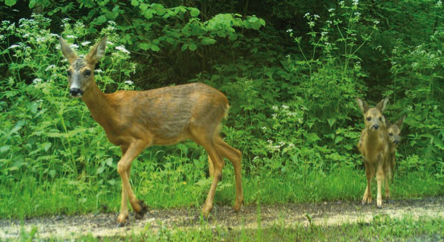
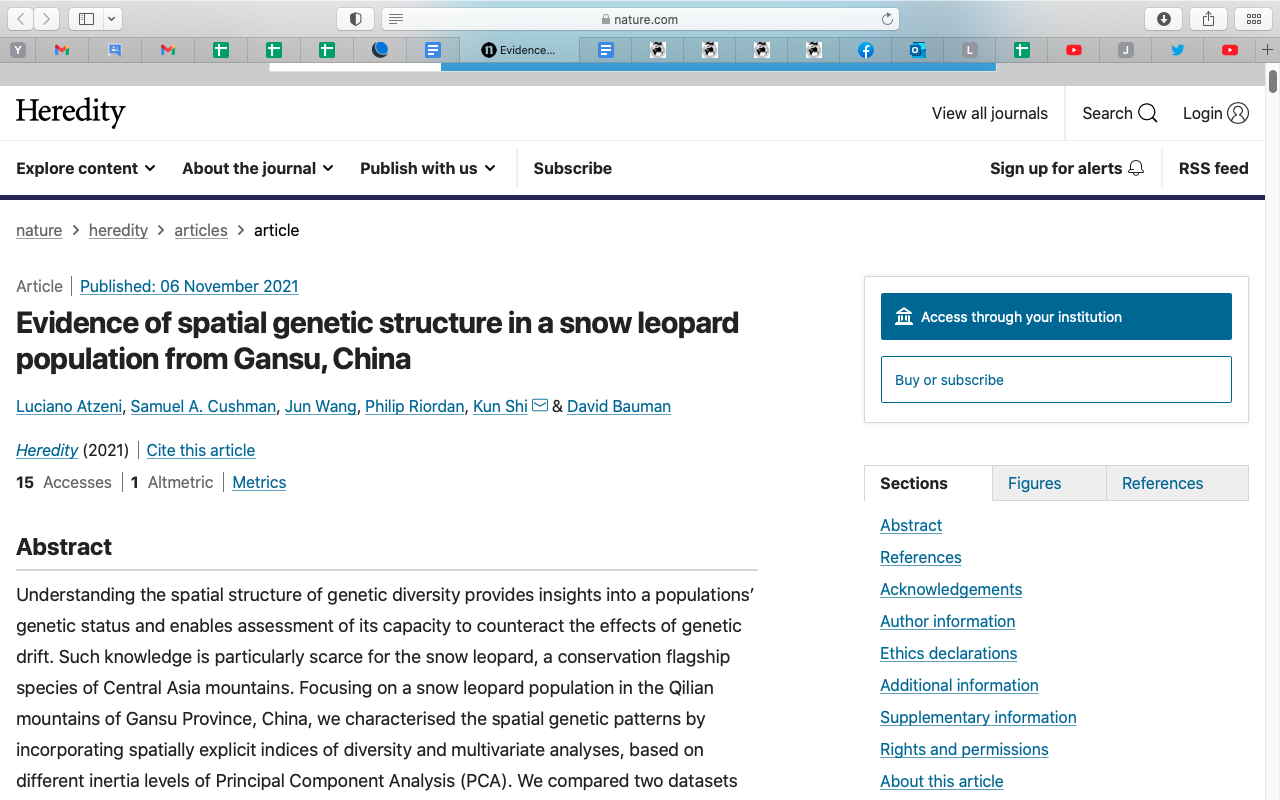
Please find details below of a new article added to our Bibliography:
Title: Evidence of spatial genetic structure in a snow leopard population from Gansu, China
Author: Azteni, L., Cushman, S. A., Wang, J., Riordan, P., Shi, K., Bauman, D.
Abstract: Understanding the spatial structure of genetic diversity provides insights into a populations’ genetic status and enables assessment of its capacity to counteract the effects of genetic drift. Such knowledge is particularly scarce for the snow leopard, a conservation flagship species of Central Asia mountains. Focusing on a snow leopard population in the Qilian mountains of Gansu Province, China, we characterised the spatial genetic patterns by incorporating spatially explicit indices of diversity and multivariate analyses, based on different inertia levels of Principal Component Analysis (PCA). We compared two datasets differing in the number of loci and individuals. We found that genetic patterns were significantly spatially structured and were characterised by a broad geographical division coupled with a fine-scale cline of differentiation. Genetic admixture was detected in two adjoining core areas characterised by higher effective population size and allelic divers
ity, compared to peripheral localities. The power to detect significant spatial relationships depended primarily on the number of loci, and secondarily on the number of PCA axes. Spatial patterns and indices of diversity highlighted the cryptic structure of snow leopard genetic diversity, likely driven by its ability to disperse over large distances. In combination, the species’ low allelic richness and large dispersal ability result in weak genetic differentiation related to major geographical features and isolation by distance. This study illustrates how cryptic genetic patterns can be investigated and analysed at a fine spatial scale, providing insights into the spatially variable isolation effects of both geographic distance and landscape resistance.